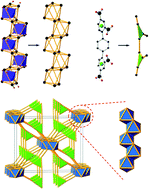A series of homonuclear lanthanide coordination polymers based on a fluorescent conjugated ligand: syntheses, luminescence and sensor for pollutant chromate anion†
Abstract
A family of six new homo-lanthanide coordination polymers incorporating a conjugated ligand of 2,5-di(2′,4′-dicarboxylpheny)pyridine, namely, {[Ce(μ3−ddpp)]·4H2O}n (1), {[Nd(μ3−ddpp)]·2H2O}n (2), {[Sm(μ6−ddpp)]·H2O}·H2O}n (3), {[Eu(μ6−ddpp)]·H2O}n (4), {[Tb(μ6−ddpp)]·H2O}n (5), and {[Er(μ6−ddpp)]·H2O}n (6) (H3ddpp = 2,5-di(2′,4′-dicarboxylpheny)pyridine acid), has been prepared successfully through solvothermal reactions. Polymers 1–6 exhibit various coordination environments and different multi-dimensions, but they are all assembled in a one dimensional (1-D) Ln–carboxylate chain. Polymer 1 only shows a 1-D ribbon chain, while polymer 2 exhibits a binodal (3, 8)-connected topology net. Heavy lanthanide polymers 4–6 possess 3D frameworks based on a rare (4, 8)-connected msw framework. Thermogravimetric and different thermal analysis measurements indicate that they all display high thermal stability. The luminescence emission spectra display characteristic f–f transition emissions of Ln(III) polymers in visible or near infrared (NIR) regions. The fluorescent ligand H2ddpp provides efficient energy transfer for the sensitization of Eu(III) and Tb(III) ions in the visible region, among which a Tb(III) polymer may be employed as a fluorescence ratiometric probe for the pollutant CrO42− anion.


 Please wait while we load your content...
Please wait while we load your content...